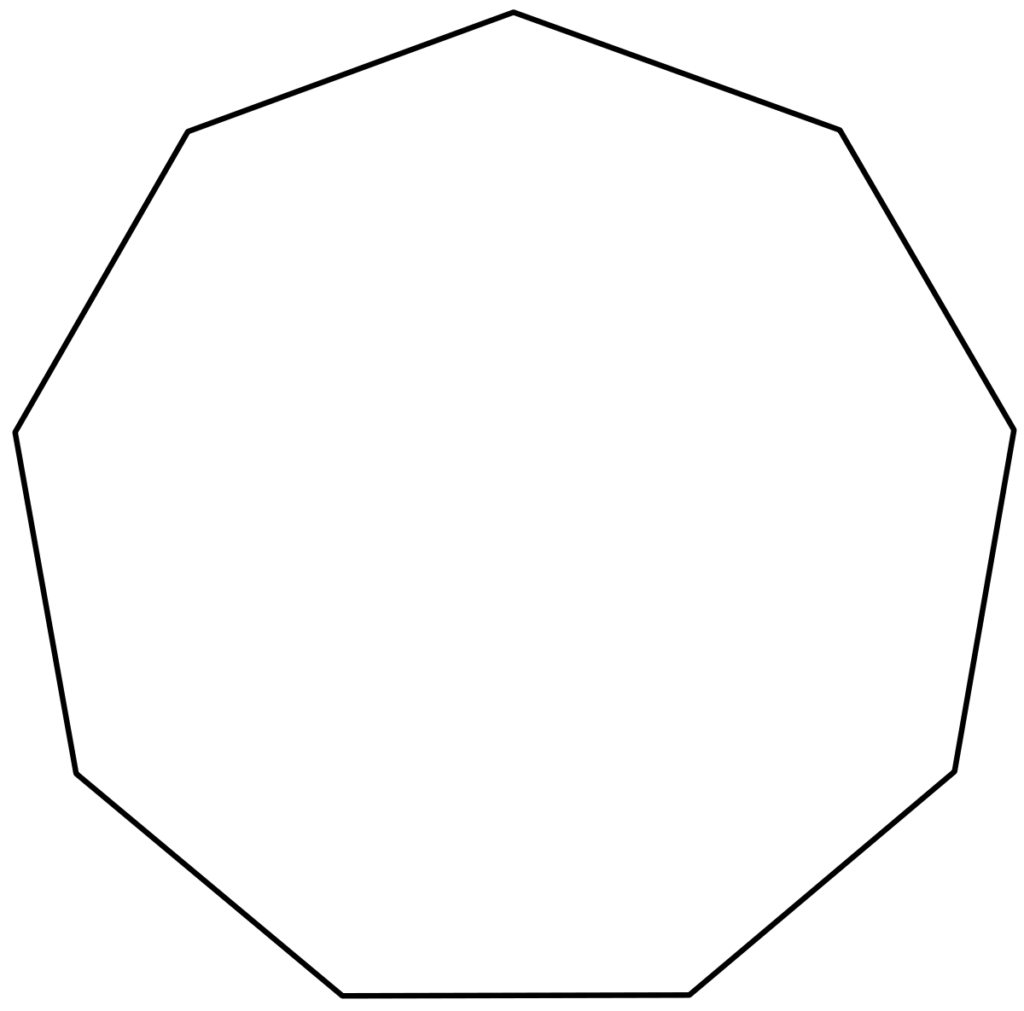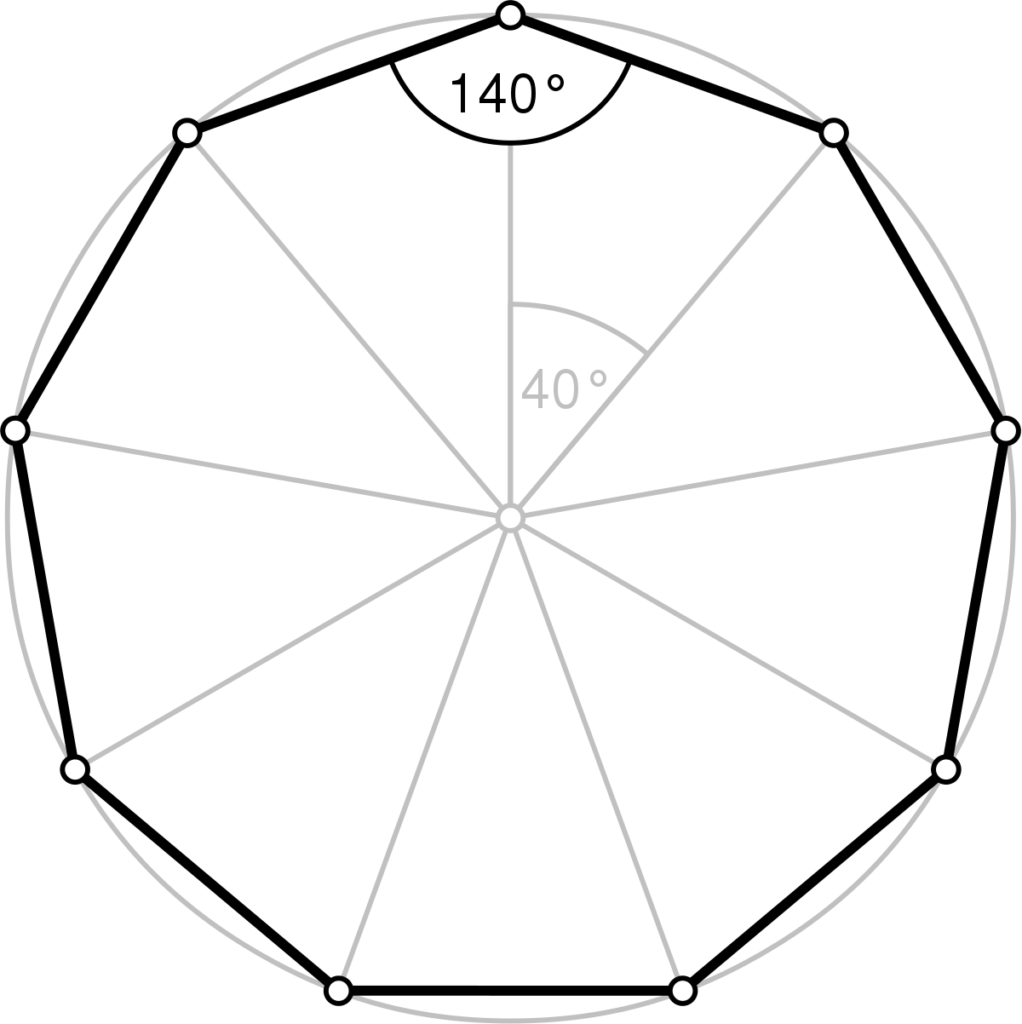Nonagon is a 9-sided polygon derived from Greek which is called enneagon or 9-gon. The first use of this shape dates back to the 1600s, making it a polygon with nine angles featured with nine sides.
It has 9 exterior angles, 9 interior angles, 9 sides, and 27 diagonals, of which the sum of all interior angles equals 1260 degrees.
Want to learn more about nonagon shape, size, types, and properties? This article will inform you about everything you need to know about Nonagon. We have listed the types of nonagon, and some important practice questions with solved examples to help you better understand what Nonagon is.
Why is it Called Nonagon?
One of the reasons it is called Nonagon is that it is a 9-sided polygon or 9-gon. The word ‘nona’ comes from the Latin word, which means ‘nine’, and ‘gon’ means ‘sides’. So, nonagon means ‘nine-sided shape.’

Different Types of Nonagon
There are 2 types of nonagons. Let’s dive in to know about them:
1. Regular Nonagons
A regular nonagon features all congruent and equiangular sides. You can check the image below to understand what a regular nonagon looks like.

2. Irregular Nonagons
Irregular nonagons are those nonagons in which all angles and sides are unequal. One of the most common shapes of an irregular nonagon is mentioned below:

Properties of Nonagon
A nonagon contains 9 straight sides, and 9 vertices connecting these sides. The sum of all interior angles equals 1260 degrees.
Now, that you know a nonagon is of 2 types. Let’s know about it’s properties:
1. Regular Nonagon
Listed below are the important properties of regular nonagon:
- Every interior angle of a regular nonagon is measured precisely at 140 degrees.
- The central angle measure is 40 degrees when divided into triangles, as shown in the source.
- The sum of all angles will always be equal to 360 degrees.
- The perimeter of this nonagon with side ‘a’ equals 9a.
- It can be divided into 9 isosceles triangles with equal area. It implies a regular nonagon always has 9 isosceles triangles.
2. Irregular Nonagon
- Irregular nonagons are the ones that do not have equal sides and angles.
- The sum of all its interior angles equals 1260 degrees, even after having unequal sides and angles.
How Many Sides Are Present in Nonagon?
A nonagon comprises 9 sides. The name also denotes 9 sides as ‘nona’ means 9, and ‘gon’ is described as sides.
The figure below depicts the total sides present in a nonagon:

All 9 sides of the above nonagon are represented by AB, BC, CD, DE, EF, FI, IH, HG, and GA.
Diagonals of Nonagon
The total diagonals of nonagon are 27, which can be seen in the image below:

Solved Examples
To brief you more about the nonagon’s concept, here are some solved questions.
1. Calculate the perimeter of a regular nonagon whose 1 side is 6 units.
A1. To find the perimeter of the regular nonagon, we need to know the length of all 9 sides. The sum of all 9 sides will be equal to the perimeter of the nonagon. However, if it is a regular nonagon, we need to know the length of only 1 side and multiply it by 9 to find the perimeter.
So, as per this question, the length of one side of a regular nonagon is 6 units. If we apply the formula:
Perimeter of a regular nonagon = 9a (where ‘a’ is the length of 1 side of the nonagon)
Therefore, the perimeter of the nonagon is (9 x 6 units), which is equal to 54 units.
2. What will be the sum of the non 180agon’s interior angle?
A2. Using the appropriate formula:
Sum of interior angles of a polygon = (n-2) x 1800
Here, ‘n’ represents the number of sides of the polygon.
According to the above question, we have got a nonagon, which means ‘n’= 9.
Therefore, Sum of the interior angles of the nonagon is:
(9-2) x 1800 = 12600
Practice Problems + Answer Key
Here are a few practice questions with detailed answers. Let’s go through them:
1. A concave nonagon is one in which at least one interior angle is …………….
A. Reflex Angle
B. Right Angle
C. Obtuse Angle
D. Acute Angle
A1. The reflex angle is always more than 180 degrees. The answer to this question is A, which is a reflex angle.
A Concave nonagon will be identified as concave only when one or more interior angles are larger than 180 degrees. In case each interior angle is less than 180 degrees, it is classified as a convex polygon.
2. Each interior angle of regular nonagon measures …………
A. 110 degrees
B. 120 degrees
C. 130 degrees
D. 140 degrees
A2. Every interior angle of a regular nonagon always measures 140 degrees.
3. How many isosceles triangles are divided in a regular nonagon?
A. 6
B. 8
C. 7
D. 9
A3. 9 congruent isosceles triangles are formed with equal area in a regular nonagon.
4. The sum of the exterior angle of a regular nonagon is ………….
A. 180 degrees
B. 120 degrees
C. 240 degrees
D. 360 degrees
A4. All exterior angles sum is equal to 360 degrees in the case of a regular nonagon.
FAQs
1. What are Polygons?
The polygons are geometric figures having a definite number of sides. It’s a two-dimensional shape with a minimum of 3 straight sides and angles.
The outline or the line segments of polygons are called Sides, and the Vertex or Corners, determined by the point where 2 line segments meet.
2. What is a 100-sided shape called?
A hectogon represents a 100-sided polygon or 100-gon. The sum of all interior angles equals 17640 degrees of a hectogon.
3. What is an 11-sided Shape called?
A hendecagon represents an 11-gon or 11-sided shape figure of which the sum of all interior angles is 1620 degrees.
4. What are the 8 Polygons?
Listed below are the 8 polygons starting with 3 sides and ending with 10.
1. Triangle (3 sides)
2. Quadrilateral (4 sides)
3. Pentagon (5 sides)
4. Hexagon (6 sides)
5. Heptagon (7 sides)
6. Octagon (8 sides)
7. Nonagon (9 sides)
8. Decagon (10 sides)
So, this was all about nonagon. Get on board for more such topics to hone your academic skills.
Happy learning!



